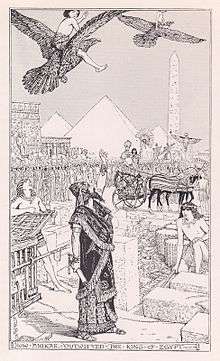Story of Ahikar
Ahiqar or Ahikar was an Assyrian sage known in the ancient Near East for his outstanding wisdom.

The Story of Ahikar, also known as the Words of Ahikar, has been found in an Aramaic papyrus of 500 B.C. among the ruins of Elephantine. The narrative of the initial part of the story is expanded greatly by the presence of a large number of wise sayings and proverbs that Ahikar is portrayed as speaking to his nephew. It is suspected by most scholars that these sayings and proverbs were originally a separate document, as they do not mention Ahikar. Some of the sayings are similar to parts of the Biblical Book of Proverbs, others to the deuterocanonical Wisdom of Sirach, and others still to Babylonian and Persian proverbs. The collection of sayings is in essence a selection from those common in the Middle East at the time.
Achiacharus is the name occurring in the Book of Tobit as that of a nephew of Tobit (Tobias) and an official at the court of Esarhaddon at Nineveh. There are references in Romanian, Slavonic, Armenian, Arabic and Syriac literature to a legend, of which the hero is Ahikar for Armenian (Խիկար Xikar), Arabic and Syriac. It was pointed out by scholar George Hoffmann in 1880 that this Ahikar and the Achiacharus of Tobit are identical. It has been contended that there are traces of the legend even in the New Testament, and there is a striking similarity between it and the Life of Aesop by Maximus Planudes (ch. xxiii-xxxii). An eastern sage Achaicarus is mentioned by Strabo.[1] It would seem, therefore, that the legend was undoubtedly oriental in origin, though the relationship of the various versions can scarcely be recovered.[2]
Narrative
In the story, Ahikar was chancellor to the Assyrian kings Sennacherib and Esarhaddon. Having no child of his own, he adopted his nephew Nadab/Nadin, and raised him to be his successor. Nadab/Nadin ungratefully plotted to have his elderly uncle murdered, and persuades Esarhaddon that Ahikar has committed treason. Esarhaddon orders Ahikar be executed in response, and so Ahikar is arrested and imprisoned to await punishment. However, Ahikar reminds the executioner that the executioner had been saved by Ahikar from a similar fate under Sennacherib, and so the executioner kills a prisoner instead, and pretends to Esarhaddon that it is the body of Ahikar.
The remainder of the early texts do not survive beyond this point, but it is thought probably that the original ending had Nadab/Nadin being executed while Ahikar is rehabilitated. Later texts portray Ahikar coming out of hiding to counsel the Egyptian king on behalf of Esarhaddon, and then returning in triumph to Esarhaddon. In the later texts, after Ahikar's return, he meets Nadab/Nadin and is very angry with him, and Nadab/Nadin then dies.
British classicist Stephanie West has argued that the story of Croesus in Herodotus as an adviser to Cyrus I is another manifestation of the Ahiqar story.[3]
Notes
- ↑ Strabo, Geographica 16.2.39: "...παρὰ δὲ τοῖς Βοσπορηνοῖς Ἀχαΐκαρος..."
- ↑
 One or more of the preceding sentences incorporates text from a publication now in the public domain: Chisholm, Hugh, ed. (1911). "Achiacharus". Encyclopædia Britannica. 1 (11th ed.). Cambridge University Press. p. 143.
One or more of the preceding sentences incorporates text from a publication now in the public domain: Chisholm, Hugh, ed. (1911). "Achiacharus". Encyclopædia Britannica. 1 (11th ed.). Cambridge University Press. p. 143. - ↑ "Croesus' Second Reprieve and Other Tales of the Persian Court," Classical Quarterly (n.s.) 53 (2003): 416-437.
References
- A version of the Story of Ahikar can be found in The Lost Books of the Bible and the Forgotten Books of Eden
External links
| Wikiquote has quotations related to: Story of Ahikar |
- The Story of Ahikar
- AḤIḳAR at JewishEncyclopedia.com
- The First Purim
- "Memories of Sennacherib in Aramaic Tradition"